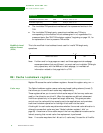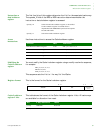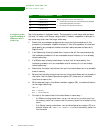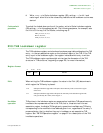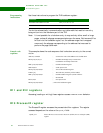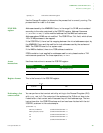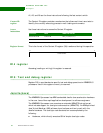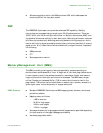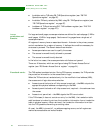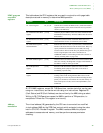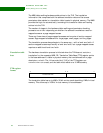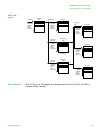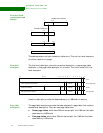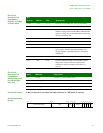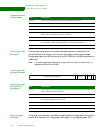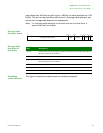
WORKING WITH THE CPU
MemoryManagement Unit (MMU)
106 Hardware Reference NS9215
Invalidate entire TLB using R8: TLB Operations register (see “R8:TLB
Operations register” on page 97).
Invalidate TLB entry selected by MVA, using R8: TLB Operations register (see
“R8:TLB Operations register” on page 97).
Lockdown of TLB entries using R10: TLB Lockdown register (see “R10:TLB
Lockdown register” on page 101).
Access
permissions and
domains
For large and small pages, access permissions are defined for each subpage (1 KB for
small pages, 16 KB for large pages). Sections and tiny pages have a single set of
access permissions.
All regions of memory have an associated domain. A domain is the primary access
control mechanism for a region of memory. It defines the conditions necessary for
an access to proceed. The domain determines whether:
Access permissions are used to qualify the access.
The access is unconditionally allowed to proceed.
The access is unconditionally aborted.
In the latter two cases, the access permission attributes are ignored.
There are 16 domains, which are configured using R3: Domain Access Control
register (see “R3:Domain Access Control register” on page 91).
Translated entries The TLB caches translated entries. During CPU memory accesses, the TLB provides
the protection information to the access control logic.
When the TLB contains a translated entry for the modified virtual address (MVA),
the access control logic determines whether:
Access is permitted and an off-chip access is required — the MMU outputs the
appropriate physical address corresponding to the MVA.
Access is permitted and an off-chip access is not required — the cache services
the access.
Access is not permitted — the MMU signals the CPU core to abort.
If the TLB misses (it does not contain an entry for the MVA), the translation table
walk hardware is invoked to retrieve the translation information from a translation
table in physical memory. When retrieved, the translation information is written
into the TLB, possible overwriting an existing value.
At reset, the MMU is turned off, no address mapping occurs, and all regions are
marked as noncachable and nonbufferable.



